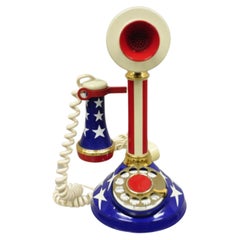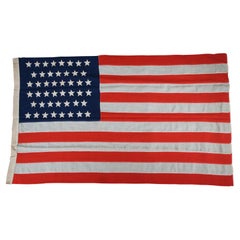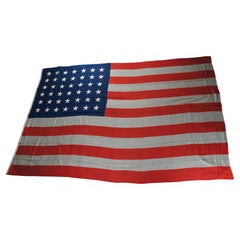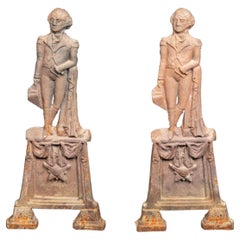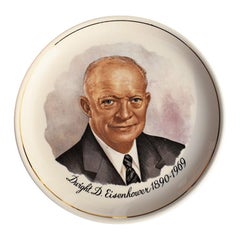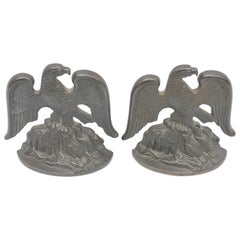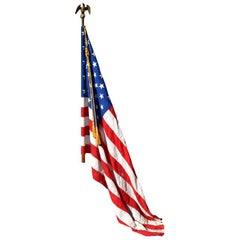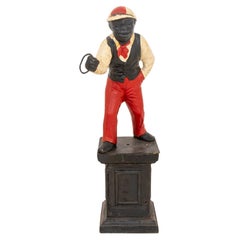American Classical Political and Patriotic Memorabilia
7
to
1
7
7
7
7
20
8
7
5
2
1
1
1
1
1
2
5
2
1
1
1
1
1
3
2
1
1
1
3
2
1
1
Style: American Classical
Vintage Deco-Tel Rotary Phone Telephone American Flag Patriotic 1970s
Located in Philadelphia, PA
Vintage Deco-Tel Rotary Phone Telephone American Flag Patriotic 1970s. Circa 1970s. Measurements: 12" H x 5.5" W x 5.5" D.
Category
1970s Vintage American Classical Political and Patriotic Memorabilia
Materials
Plastic
Antique 46 Star WMH Horstmann Company United States of America Flag 83"
By Horstmann
Located in Dayton, OH
Antique forty six star large wool American flag by Horstmann Company, circa 1908-1912.
Horstmann firm was founded by William H. Horstmann (1785-1850), who had immigrated to Philadelphia from Germany. Horstmann bought out a local swordmaker in 1828 and thereafter entered the military goods field. The firm benefitted from the Civil War, becoming the largest military goods supplier in the nation by 1864.
WILLIAM H. HORSTMANN & SONS, Manufacturers of Dress Trimmings and Military Goods. 5th & Cherry Streets, Philadelphia, PA.
This house was founded, in 1815, by William H. Horstmann, a native of Cassel, in Germany. He had learned the trade of silk-weaving in France, and, emigrating to the United States in the above-mentioned year, established himself in Philadelphia as a manufacturer of fringe, laces and trimmings of various kinds. He married the daughter of Frederick Hoeckly, a German settler in Philadelphia, and also a manufacturer of fringe, coach-lace and tassels. He devised several improvements in this trade, especially by introducing varieties in the styles and patterns of this class of goods, there being at that time only two patterns used in the trade, which were known as the Jefferson pattern and the Monroe pattern.
In 1824, he introduced into this country from Germany the use of plaiting or braiding machines, and about the same time he was the first to introduce into this country the use of the Jacquard loom, for weaving patterns in textile fabrics. His location was in the first instance at No. 50 North Third street, but within a short time he removed to a store next to the Harp and Crown tavern, afterwards known as the City hotel, and continued his business within a short distance of this point for many years.
In 1828, he commenced the manufacture of military trimmings as a special department, and this branch has grown to most important proportions, Horstmann's military goods being in demand throughout time country. The firm have also executed large Government contracts in this line for the War and Navy Departments. In 1831, he established a branch house in New York city, and about the same time erected a factory at the corner of Germantown road and Columbia avenue. The factory was continued here until time erection of the extensive building at Fifth and Cherry streets, where the works, salesrooms and offices of time firm now are. This massive structure is six stories high, and extends 140 feet on Fifth street and 200 on Cherry street, and reaches back to Race street. The separate departments into which the business is divided are thirty in number. More than 1000 distinct looms and machines are in use in the building, many of them very costly and some invented and used exclusively by this firm, the motive power being supplied by a steam engine of fifty horse power. The area covered by the works is about 11,000 square feet. Time number of hands employed is very large, about 500. When the erection of a vast factory at this point was first proposed, a strong opposition was made by time holders of the neighboring property. The ancient German Lutheran Church and burying ground, since removed, stood opposite the site, and a bill was introduced into the Legislature to forbid the use of a steam engine within 100 yards of any place of worship. The interests which such a bill would have affected injuriously, especially those of several newspapers, roused a strong opposition to it, and it failed to become a law. In 1845, William H. Horstmann, the founder of the house, retired from the business, and his two sons, William and Sigmund, assumed the management and it was under their direction that the new building, above described, was erected.
The goods produced by this house are of almost endless extent and variety. They include goods woven from all the various textile fibres—cotton, wool, silk, etc.—in every style, color and pattern, and are used for an infinite number of purposes. Narrow woven goods are time staple production, made up into material for dresses for both sexes, for use in daily life, and for regalia for ""societies;"" for the costumes of the stage, the upholstering of houses and of carriages, the uniforms of soldiers, together with equipments for the same, and for funeral purposes. The raw material used in the manufacture is to a great extent very costly, and their store rooms often hold as much as $200,000 worth of goods in an unworked state. There are two rooms devoted to power looms in the factory, one for coach lace and one for other styles of weaving, in which about 250 of these machines are constantly running. The braiding machines in the coach lace room are very noteworthy. The cord to be covered with braid is drawn through an opening in time middle of a flat, circular, metallic plate, about 15 inches across. Up to a point on this cord, about a foot above the plate, the threads of the braiding material converge, like the ribs of a tent-roof, and there weave in and out and out and in, as the coating of braid grows, and time covered cord rises and is wound away above. The weaving is accomplished by the motion of the spools below that carry the different threads of the braid. These spools stand in uprights, which are carried round and amongst each other in curved slots in the above-mentioned broad metallic plate. All but two of these spools run in and out among each other, with a swift, easy and intricate motion, mind so rapid that time eye can hardly follow it, while one or two special spools run steadily round and round among time twisting spools with the most extreme swiftness. Many other machines, displaying equally ingenious mechanism, are used in the factory. The various details of equipment manufactured and supplied by this house are also important, both for their number and the superior quality of the manufacture.
The one article of swords may be taken as an instance. This trade grew naturally and immediately out of the established army and navy goods department of the works, it being necessary that the sword itself should be furnished together with the sword-belt and other trappings all complete. Every part of the sword and trappings, with the exception of the blade, is made on the premises. The blades are almost all imported from the ancient German sword-blade emporium of Solingen, where, it is said, swords have been made ever since the year 1147, when Count Adolphus of Berg brought home from the East and established there the business of forging Damascus blades. There is in this department a stock of some thousands of blades, of many different patterns and sizes, ready to be set and finished. Any style or sword can be had from this warehouse, from the plainest kind up to a presentation sword...
Category
1910s Vintage American Classical Political and Patriotic Memorabilia
Materials
Wool
Rare Monumental 1890 Antique 42 Star United States of America Flag
Located in Dayton, OH
Monumental fifteen foot 42 star American flag, circa 1889-1890.
The 42-star flag is rare because only a limited number of 42-star flags were produced after Washington became a state on Nov. 11, 1889.
But it takes a more intimate knowledge of flag trivia to know just why it happened this way.
White stars are added to the blue field of the star-spangled banner on the Fourth of July after a state is admitted to the union. In the fall of 1889, several western territories became states.
Dakota was admitted, and then split into North and South Dakota, on Nov. 2, 1889, which made them state and star numbers 39 and 40. Montana was named the 41st state on Nov. 8, followed by Washington, on Nov. 11.
Only a few flag manufacturers began producing 42-star flags before the official addition of the 42nd star on July 4, 1890.
Those who tried to jump the gun by being the first to produce an up-to-date flag were surprised when Idaho was admitted to the United States on July 3...
Category
1890s Antique American Classical Political and Patriotic Memorabilia
Materials
Cotton
Pair of Cast Iron George Washington Figural Andirons
Located in New York, NY
Pair of cast iron George Washington Andirons:
Measures: 9" x 20" x 16"
Weighs: 30 LBS.
Category
Early 20th Century American American Classical Political and Patriotic Memorabilia
Materials
Iron
President Dwight D. Eisenhower Commemorative Ceramic Plate
Located in Oklahoma City, OK
A round ceramic commemorative plate of President Dwight Eisenhower. The plate is circular, with gold detail around the edges, and a portrait of Presi...
Category
20th Century North American American Classical Political and Patriotic Memorabilia
Materials
Gold
Bronze Eagle Bookends Signed and Dated, 1931
By Eagle & Young
Located in Los Angeles, CA
This is an amazing and heavy bronze bookends signed and dated Eagle & Young, 1931. These bookends are in very good condition.
Category
1930s American Vintage American Classical Political and Patriotic Memorabilia
Materials
Bronze
Historic Antique Civil War Walking Stick Cane of General Joe Hooker
Located in Dayton, OH
"Very rare antique 18th century wood walking stick, staff or cane once owned by General Joe Hooker. Engraved silver band reads Gen. Joe Hooker. Measure: 35".
A history of the cane is included which reads: “This cane was given to Chaplain Earnshaw by the family of General Joseph Hooker, who commanded the English Forces at the Battle of Chancellorsville (which he lost.) The shaft of the cane was made from the “poop” of the vessel of John Paul Jones. The handle was made from the horn of a buffalo that General Grant shot. General Hooker died with the cane in his hands as he walked down stairs. Two battles later which ended in Gettysburg, the Norths cause was settled. General grant was put in command.”
Province
Estate of J. Frederic Gagel, owner of multiple Thoroughbred race horses that competed in the Narragansett Special and Kentucky Derby. Their family heritage was strongly intertwined with the military having officers in battles dating back to the American Revolution.
John Paul Jones (born John Paul; July 6, 1747 – July 18, 1792) was a Scottish-American naval captain who was the United States' first well-known naval commander in the American Revolutionary War. He made many friends among U.S political elites (including John Hancock[1] and Benjamin Franklin[2]) as well as enemies (who accused him of piracy), and his actions in British waters during the Revolution earned him an international reputation that persists to this day. As such, he is sometimes referred to as the ""Father of the American Navy"" (a nickname he shares with John Barry and John Adams[3]).
Jones
Jones was born and raised in Scotland, became a sailor at the age of thirteen, and served as commander of several merchantmen. After having killed one of his mutinous crew members with a sword, he fled to the Colony of Virginia and around 1775 joined the newly founded Continental Navy in their fight against the Kingdom of Great Britain in the American Revolutionary War. He commanded U.S. Navy ships stationed in France, led one failed assault on Britain, and several attacks on British merchant ships. Left without a command in 1787, he joined the Imperial Russian Navy and obtained the rank of rear admiral.
Hooker
“Joseph Hooker (November 13, 1814 – October 31, 1879) was an American Civil War officer / general for the Union, chiefly remembered for his decisive defeat by Confederate General Robert E. Lee at the Battle of Chancellorsville in 1863.
Hooker had served in the Seminole Wars and the Mexican–American War, receiving three brevet promotions, before resigning from the Army. At the start of the Civil War, he joined the Union side as a brigadier general, distinguishing himself at Williamsburg, Antietam and Fredericksburg, after which he was given command of the Army of the Potomac...
Category
19th Century Antique American Classical Political and Patriotic Memorabilia
Materials
Hardwood
Related Items
Large, Decorative Bronze Sculpture of a Spartan Warrior with Sword, Greco Roman
Located in Berlin, DE
Large and decorative bronze sculpture of a Spartan warrior.
By Professor Victor Heinrich Seifert. Signed.
Excellent masterpiece. On marble base.
Category
19th Century Austrian Antique American Classical Political and Patriotic Memorabilia
Materials
Bronze
Free Shipping
H 24.02 in W 9.65 in D 5.52 in
Antique Federal Eagle American 50 Star Flag with Brass Eagle Pole, 19th Century
Located in Oklahoma City, OK
Monumental 50 star American Flag with antique Federal Eagle brass and wood pole. A patriotic piece suitable for any home. This set includes both ...
Category
19th Century American Antique American Classical Political and Patriotic Memorabilia
Materials
Brass, Bronze
H 66 in W 69 in D 1.25 in
Pair 19th Century Victorian Eastlake Free Mason Throne Chairs w/ Symbolism
Located in Savannah, GA
Victorian Eastlake large upholstered solid oak throne chairs from Masonic Lodge with lots of detailed carving. The pair consists of one with the plumb bob sy...
Category
1880s American Antique American Classical Political and Patriotic Memorabilia
Materials
Velvet, Oak
Vintage Italian Flag c.1940 (FREE SHIPPING)
Located in San Francisco, CA
ABOUT
An original Italian flag with brass grommets to hang it.
CREATOR American Flag and Banner Company, San Francisco.
DATE OF MANUFACTURE c.19...
Category
Early 20th Century American Classical Political and Patriotic Memorabilia
Materials
Brass
Antique Hand-Carved Meerschaum Smoking Pipe of Napoleon Bonaparte & Case
Located in Hamilton, Ontario
This antique well executed hand-carved meerschaum pipe was made by the Drown Pipe company of Vienna Austria and dates to approximately 1900 and done in a Renasissance Revival style. ...
Category
Early 20th Century Austrian American Classical Political and Patriotic Memorabilia
Materials
Clay
Dutch WWII Caricatures of Hitler, Göring, Stalin, Rooseveld, and Churchill
By Guust
Located in Haarlem, NL
A very remarkable collection of Folk Art caricatures made of Dutch ration 'food stamps.'
First caricature portrays a fat Hermann Go¨ring holding a cerem...
Category
Mid-20th Century Dutch American Classical Political and Patriotic Memorabilia
Materials
Paper
H 19.69 in W 12.6 in D 0.79 in
Pair Of St Nicholas Cast Iron Andirons
Located in Essex, MA
Cast as figures of a standing Santa holding toys.
Category
1880s American Antique American Classical Political and Patriotic Memorabilia
Materials
Iron
39-Star Antique American Flag with 'Whimsical' Star Pattern, 1889
Located in Colorado Springs, CO
This is a 39-star unofficial American flag, handmade and printed on cotton. The flag dates to 1889 and has a unique history, thanks to its rare star-count.
The flag’s canton is prin...
Category
1880s American Antique American Classical Political and Patriotic Memorabilia
Materials
Cotton
Pair of American Cast Iron Figural Andirons. Circa 1840
Located in Hollywood, SC
Pair of American cast iron squatting figural andirons of man and woman with original dog legs. Mid 19th Century
Category
19th Century American Antique American Classical Political and Patriotic Memorabilia
46-Star American Flag, Antique Printed on Silk, Early 20th Century
Located in Colorado Springs, CO
This is an original 46-star American parade flag, printed on silk. Each star represents a state in the Union at the time. The official flag design would update every July 4th, to inc...
Category
Early 1900s American Antique American Classical Political and Patriotic Memorabilia
Materials
Silk
Vintage WWII U.S. Navy Patriotic Banner, "Welcome Firemen" Flag, circa 1941-1945
Located in Colorado Springs, CO
This is a beautifully preserved WWII Navy aircraft carrier banner, emblazoned with a welcome for the ship's firemen.
The banner is partially printed and has sewn elements. The flag's field is dyed a rich navy blue, with a resist dyed white stripe and a sewn red stripe at both top and bottom. A large "WELCOME" is resist dyed at center, in big white letters. This is followed by a sewn yellow strip of contrasting fabric, printed with the word "FIREMEN" in blue. Thirteen white stars complete the design of this patriotic piece of WWII and Navy history.
The banner retains its original white hoist, with two metal grommets on each side, for ease in display on the ship. Along the center of the hoist is the printed name of "J.S. Sullivan." "Naugatuck, Conn." is printed along the left and the size "2 x3 FT" is printed along the right. The flag maker, Annin, has sewn in its label, boasting "guaranteed defiance fast colors."
CONDITION:
Very good condition, considering age and past use. Partially printed and hand-sewn flag construction. Some toning to the white of the flag and along the top hoist. Original grommets at left and right of the hoist. The flag measures 36" X 22". Expertly framed on black linen with an antiqued black wood...
Category
1940s American Vintage American Classical Political and Patriotic Memorabilia
Materials
Linen
H 42.5 in W 30.5 in D 1.25 in
Pair of Antique Cast Iron and Bras Andirons, Firedogs
Located in Oostvoorne, NL
Pair of antique cast iron and bras andirons - firedogs.
Category
19th Century French Antique American Classical Political and Patriotic Memorabilia
Materials
Iron
Previously Available Items
Historic Antique Civil War Walking Stick Cane of General Joe Hooker
Located in Dayton, OH
"Very rare antique 18th century wood walking stick, staff or cane once owned by General Joe Hooker. Engraved silver band reads Gen. Joe Hooker. Measure: 35".
A history of the cane is included which reads: “This cane was given to Chaplain Earnshaw by the family of General Joseph Hooker, who commanded the English Forces at the Battle of Chancellorsville (which he lost.) The shaft of the cane was made from the “poop” of the vessel of John Paul Jones. The handle was made from the horn of a buffalo that General Grant shot. General Hooker died with the cane in his hands as he walked down stairs. Two battles later which ended in Gettysburg, the Norths cause was settled. General grant was put in command.”
Province
Estate of J. Frederic Gagel, owner of multiple Thoroughbred race horses that competed in the Narragansett Special and Kentucky Derby. Their family heritage was strongly intertwined with the military having officers in battles dating back to the American Revolution.
John Paul Jones (born John Paul; July 6, 1747 – July 18, 1792) was a Scottish-American naval captain who was the United States' first well-known naval commander in the American Revolutionary War. He made many friends among U.S political elites (including John Hancock[1] and Benjamin Franklin[2]) as well as enemies (who accused him of piracy), and his actions in British waters during the Revolution earned him an international reputation that persists to this day. As such, he is sometimes referred to as the ""Father of the American Navy"" (a nickname he shares with John Barry and John Adams[3]).
Jones
Jones was born and raised in Scotland, became a sailor at the age of thirteen, and served as commander of several merchantmen. After having killed one of his mutinous crew members with a sword, he fled to the Colony of Virginia and around 1775 joined the newly founded Continental Navy in their fight against the Kingdom of Great Britain in the American Revolutionary War. He commanded U.S. Navy ships stationed in France, led one failed assault on Britain, and several attacks on British merchant ships. Left without a command in 1787, he joined the Imperial Russian Navy and obtained the rank of rear admiral.
Hooker
“Joseph Hooker (November 13, 1814 – October 31, 1879) was an American Civil War officer / general for the Union, chiefly remembered for his decisive defeat by Confederate General Robert E. Lee at the Battle of Chancellorsville in 1863.
Hooker had served in the Seminole Wars and the Mexican–American War, receiving three brevet promotions, before resigning from the Army. At the start of the Civil War, he joined the Union side as a brigadier general, distinguishing himself at Williamsburg, Antietam and Fredericksburg, after which he was given command of the Army of the Potomac...
Category
19th Century Antique American Classical Political and Patriotic Memorabilia
Materials
Hardwood
Cast Iron Polychromed Jockey Figure, 20th Cetury
Located in New York, NY
Cast Iron polychromed figural hitching post in the form of an African American jockey or groom wearing red white and black, standing on a black base. 37" H (approx.).
Dealer: S138XX.
Category
Early 20th Century American Classical Political and Patriotic Memorabilia
Materials
Iron
1876 Antique American Centennial Bank Note Engraving 18 Presidents 36 States
By American Bank Note Company
Located in Dayton, OH
"Rare antique 1876 bank note engraving commemorating the Centennial anniversary of the United States of America and advertising the Great Falls Company; prod...
Category
1870s Antique American Classical Political and Patriotic Memorabilia
Materials
Paper
H 8.375 in W 9.5 in D 0.1 in
Vintage Solid Brass American Bald Eagle Wall Plaque Emblem Crest Heraldic
Located in Dayton, OH
Vintage solid brass bald eagle shaped wall plaque. Measure: 23".
Category
Mid-20th Century American Classical Political and Patriotic Memorabilia
Materials
Brass
Massive 31" American Flag Rag Ball Primitive Americana Sculpture Patriotic
Located in Dayton, OH
Massive intertwined Rag Ball. Made from American Flag fabrics.
Category
Late 20th Century American Classical Political and Patriotic Memorabilia
Materials
Fabric
Framed Antique American Folk Art Tattoo Art
Located in Stamford, CT
Framed antique American Folk Art tattoo art eagle wall art. Frame has overall wear, chips and should be re-framed.
Category
1940s American Vintage American Classical Political and Patriotic Memorabilia
Materials
Glass, Giltwood, Paper
Genuine Vintage Law Man Hat Milan Campaign Sheriff Ranger Police Officer
By Stratton
Located in Chula Vista, CA
Hat
The Law Man genuine Milan hat. Sheriff Officer Ranger Police uniform hat.
Style is Campaign.
Labeled Size 7
Dimensions: 14 3/4" D x 13 1/4" W x 5 3/4" Tall
Item is from vintage c...
Category
Late 20th Century American American Classical Political and Patriotic Memorabilia
Materials
Straw
H 5.75 in W 13.25 in D 14.75 in
American Civil War Era Black Metal Ballot Box by Geo Barnard & Company, 1800s
Located in Oklahoma City, OK
Black cylindrical 19th century ballot box by Geo Barnard & Company of Saint Louis Missouri. A wonderful piece of history, this State government ballot box is tall and round in form. ...
Category
Early 19th Century American Antique American Classical Political and Patriotic Memorabilia
Materials
Metal, Tin
19th Century George Washington Cast Iron Stove Figure
Located in Essex, MA
A striking 19th century cast iron figure of George Washington, the full-body figure composed of two joined halves with a well detailed head, body and robe details, the back inscribed in cursive, in the casting, "Design Patented Aug. 26, 1843," together with a carved and white-painted Ionic column capital.
Provenance: The Collection of Frederic and Jean Sharf
This cast iron figure of George Washington is one of the most striking of all 19th century "dumb stoves." These usually did not have a firebox, but were connected by a stovepipe to a functioning stove on a floor below. That way two rooms could be heated by one stove. The designer, Alonzo Blanchard (1799-1864), chose Washington because the country was preoccupied with the nation's first president as a symbol of unity. In this guise, Washington is shown wearing a Roman toga over 18th century clothing. Blanchard probably based his design on the 1826 marble statue of Washington by Francis Chantrey, installed in the Massachusetts State House.
(Source: The Albany Institute)
Measures: Height 47 inches
Height on column capital base...
Category
Mid-19th Century American Antique American Classical Political and Patriotic Memorabilia
Materials
Iron
Early August Buermann Hand-Forged Carbon Steel Spurs and Original Leather Straps
By August Buermann
Located in Ottawa, Ontario
Early August Buermann hand-forged carbon steel spurs and original leather straps, circa 1880-1890, The spurs are complete and original, still retaining the spur bells, tooled leather boot covers, chain, wheel spurs, the spurs are in as found condition and have not been cleaned or restored in any way.
The spurs have the company’s brand marks “AB” inside a star together with “PAT’D” of each of the spurs. August Buermann immigrated to the US from Germany in 1864 and enlisted with the US Army. He fought in the Civil War and afterward returned to Newark, NJ which was a major manufacturing city and worked for Alexander Barclay’s company. Buermann was a great businessman and bought out Barclay and renamed the company Buermann Manufacturing Co in 1866. Over the next 60 years Buermann’s company produced the most complete catalog of bits and spurs...
Category
Late 19th Century American Antique American Classical Political and Patriotic Memorabilia
Materials
Steel
H 3 in W 10 in D 4.5 in
Pair of Framed Mini 46 Star Parade Flags
Located in Los Angeles, CA
The distressed blue custom-made wood frames contain 46 star parade flags hand-sewn on cream cotton linen are sold as a pair. Great addition to any Americana co...
Category
Early 20th Century American American Classical Political and Patriotic Memorabilia
Materials
Cotton
Pair of Framed 48 Star Parade Flags
Located in Los Angeles, CA
These folky and fun faded parade flags are newly framed in distressed painted wood frames and sewn on beige cotton linen. Great decorative accents in your boys room or Folk Art colle...
Category
1920s American Vintage American Classical Political and Patriotic Memorabilia
Materials
Cotton
American Classical political and patriotic memorabilia for sale on 1stDibs.
Find a broad range of unique American Classical political and patriotic memorabilia for sale on 1stDibs. Many of these items were first offered in the Late 20th Century, but contemporary artisans have continued to produce works inspired by this style. If you’re looking to add vintage political and patriotic memorabilia created in this style to your space, the works available on 1stDibs include folk art, more furniture and collectibles, building and garden elements and other home furnishings, frequently crafted with metal, fabric and other materials. If you’re shopping for used American Classical political and patriotic memorabilia made in a specific country, there are North America, and United States pieces for sale on 1stDibs. While there are many designers and brands associated with original political and patriotic memorabilia, popular names associated with this style include Eagle & Young, and Horstmann. It’s true that these talented designers have at times inspired knockoffs, but our experienced specialists have partnered with only top vetted sellers to offer authentic pieces that come with a buyer protection guarantee. Prices for political and patriotic memorabilia differ depending upon multiple factors, including designer, materials, construction methods, condition and provenance. On 1stDibs, the price for these items starts at $125 and tops out at $18,000 while the average work can sell for $898.
